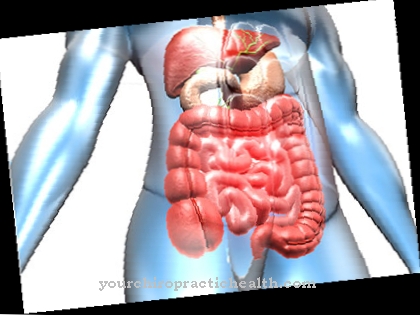What is a pain stimulus for one does not automatically have to be for another. A particularly pronounced pain sensation does not automatically have a disease value. If, on the other hand, there is hardly any pain sensation, one can Hypalgesia exist. In this case, it is a nociceptor disorder.
What is hypalgesia?

© whitehoune - stock.adobe.com
The first instance of the human perception of pain are sensory cells of the skin's senses. These sensory cells correspond to nociceptors. These are free nerve endings from sensitive neurons in the spinal cord. Nociceptors are found in all pain-sensitive body tissues and give the central nervous system feedback about tissue damage.
In addition to surface pain on the skin, nociceptors report deep pain in the muscles and bones as well as pain in the organs. The sensitivity of the receptors is related to the pain threshold. Nociception is individual to a certain extent.
An increased or decreased pain sensation does not automatically have to be related to an illness. Above a certain limit, however, abnormal pain perception is associated with disease value. One such phenomenon is the Hypalgesia. With this phenomenon, the sensation of pain is greatly reduced.
This is to be distinguished from allodynia, in which the sensation of pain is exaggerated due to over-reactive nociceptors. Both phenomena are referred to as sensitivity disorders and as such are often associated with neurogenic diseases.
causes
The cause of hypalgesia and thus reduced pain perception is often a neurological disease. If the sensation of pain is reduced due to nerve damage in the peripheral nervous system, the nociceptors react to pain stimuli with the development of an action potential. However, the excitation does not reach the central nervous system due to a peripherally disturbed pathway and thus does not pass into consciousness.
Peripheral nerve damage includes polyneuropathies in which nerves in the peripheral nervous system demyelinate. Myelin isolates the nerve lines and protects them from a loss of excitation. In polyneuropathies, the myelin is broken down around peripheral nerves. The primary cause of this phenomenon can be infections, metabolic disorders such as diabetes mellitus, previous trauma, inflammation, poisoning or malnutrition.
If hypalgesia is caused by damage to the central nervous system, the damage can be inflammation, tumors or degenerative phenomena. For example, inflammation in the spinal cord or the areas of the brain for processing pain is often caused by the autoimmune disease multiple sclerosis.
Spinal cord infarctions, strokes or herniated discs can also cause centrally mediated sensitivity disorders. There does not necessarily have to be a physical cause. Psychoneuroses can also cause hypalgesia.
Symptoms, ailments & signs
A patient with hypalgesia does not experience pain stimuli as painful up to an unusually high intensity. With this phenomenon, the person affected suffers from the symptom of a superordinate disease. All other symptoms depend on the primary cause of the sensory disturbance.
If the disturbed pain perception is related to lesions in the brain or spinal cord, those affected often complain, for example, of more or less severe headache or back pain, especially in the case of inflammation in the central nervous system.
Depending on the cause, hypalgesia can be associated with other sensory disorders in the sense of a reduced perception of other sensory qualities. For example, the general perception of temperature or touch may be restricted at the same time.
Parasitic sensations such as the general numbness of certain areas of the body can also accompany hypalgesia. Contrary to what many people suspect, numbness does not have to be automatically associated with hypalgesia and can, for example, only affect the sensation of touch or temperature.
If there are no other neurological symptoms besides hypalgesia, a psychoneurosis due to a “debilitating” event is the most likely cause. In this context, hypalgesia can be an expression of mental incapacity. A psychological loss of sensitivity to pain is often caused by an extreme experience of pain.
Diagnosis & course of disease
The diagnosis of hypalgesia is usually made by a neurologist. As part of sensitivity tests, the neurologist checks all the qualities of the skin's senses. Diagnosed hypalgesia should not be taken as an actual diagnosis. The diagnosis is only made when the primary cause of hypalgesia has been identified and the sensitivity disturbance has been traced back to a primary disease.
For example, centrally mediated hypalgesia is attributed to illnesses or pathological processes in the central nervous system in the context of diagnostics. In order to classify the cause of hypalgesia, the doctor uses imaging procedures and nerve conduction tests. If there is no lesion in either the central or peripheral nervous system, the emotional disorder is a psychosomatic phenomenon.
Complications
The hypalgesia leads to considerable sensitivity disorders in the patient. These disorders lead to a false or insufficient perception of the feeling of pain. As a rule, hypalgesia means that the person concerned does not recognize certain complaints and the diseases are treated with delay.
This can lead to various complaints and complications if various diseases or infections are discovered and treated late. Different areas can be numb or completely paralyzed. In some cases this results in restricted mobility for the patient. It is not uncommon for those affected to suffer from pain in the head and back. This pain can spread to other regions of the body and lead to discomfort there.
In some cases, the patient's perception of temperature is severely restricted by the hypalgesia, which can lead to burns. There are no further complications in treating hypalgesia. It takes place with the help of antibiotics or surgery. In some cases, therapies are also necessary to restore the patient's sensitivity. Life expectancy is usually not affected by hypalgesia.
When should you go to the doctor?
If strong pain stimuli and abnormal sensations occur again and again that cannot be traced back to a specific cause, this may be due to hypalgesia. A doctor must be consulted if the symptoms do not go away on their own or if they rapidly increase in intensity. If there are other symptoms such as paresthesia or numbness, it is best to consult a doctor immediately. The same applies to a disturbed temperature sensation or even fever.
Medical advice is required at the latest when serious complications develop. Pronounced movement restrictions, chronic headaches or back pain as well as persistent numbness must be clarified. Individuals with nerve damage are particularly prone to the symptoms of hypalgesia. Likewise people with tumors, degenerative symptoms or autoimmune diseases such as multiple sclerosis. Anyone who belongs to these risk groups should consult a doctor immediately with the symptoms mentioned. The right contact person is the family doctor or a neurologist. In the event of severe complaints, the emergency doctor should be called or the patient must go to a hospital immediately.
Doctors & therapists in your area
Treatment & Therapy
Therapy for hypalgesia depends on the primary cause. In the case of diabetic polyneuropathy, for example, the patient's optimal blood sugar control is of central importance in the treatment. Infectious polyneuropathy requires drug treatment of the causative infection, such as the administration of antibiotics.
Patients can often almost completely recover from peripheral nerve damage after the cause has been eliminated. In the case of causative lesions in the central nervous system, complete regeneration often fails to occur. An exception to this can be with tumor-related hypalgesia. In this case, removal of the tumor can restore pain sensation.
In the case of degenerative causes, restoration is not possible. In the case of causal inflammatory lesions of the central nervous system, the inflammation must first be brought under control through the administration of medication. Injuries to the central nervous system leave scars. The affected nerve tissue is permanently impaired in its function and cannot fully recover due to the high degree of specialization.
However, the functions of the defective tissue can be transferred to the neighboring nerve cells as part of a sensitivity therapy. In the case of psychologically caused hypalgesia, the triggering event is processed in psychotherapeutic care.
You can find your medication here
➔ Medicines for painOutlook & forecast
Depending on the type and severity of the hypalgesia, persistent complaints can occur that severely limit the quality of life. The prognosis is positive for mildly pronounced sensory disorders. Then drug treatment is often enough to reduce the symptoms to such an extent that a normal life is possible.
If the hypalgesia is severe, with severe headache and back pain, a full recovery is unlikely. Patients are often impaired throughout their life and need everyday support in later life. In the worst case, serious illnesses are not recognized in time as a result of the disturbed pain perception. Any infections or internal illnesses are then sometimes well advanced and potentially fatal. If the sensation of temperature is also disturbed, burns and frostbite and the associated consequences can also occur.
These significant restrictions often lead to the development of psychological complaints, which in turn reduce the quality of life. However, life expectancy is usually not reduced by hypalgesia. However, early and comprehensive treatment is necessary in every case. A positive prognosis can be made through drug therapy combined with physiotherapy and behavioral therapy.
prevention
Physically caused hypalgesia can only be prevented to the extent that degenerative, infectious and autoimmune diseases, cancer, hypoxia and trauma to the nervous tissue can be prevented: so hardly. Mentally conditioned hypalgesia, on the other hand, can be prevented by processing stressful events.
Aftercare
With hypalgesia, aftercare focuses on regular consultations with a specialist. The doctor will ask the patient about the current pain sensation and adjust the medication if necessary. In most cases, this is not necessary, as the hypalgesia is usually treatable and disappears by itself after the treatment of the causative disease has been completed.
The follow-up controls only have to take place monthly and later every six months. If no further insensitivity to pain is found, visits to the doctor can be discontinued. Because the illness often causes psychological complaints, psychological treatment is useful after the therapy.
The same applies if the reduced pain sensation is due to a mental illness. Then the person concerned should consult a therapist and, if necessary, go to a self-help group. Which measures make sense in detail always depends on the intensity of the illness and requires initial advice from a specialist.
In the case of chronic complaints, such as those that can occur in neurological diseases, comprehensive therapeutic support is always required. The patient must also take medication and have the medication regularly adjusted to the current state of health. Unlike allodynia, hypalgesia usually has physical causes that need to be determined. Depending on the type of ailment, this can sometimes take several months or even years.
You can do that yourself
In the case of hypalgesia, the causal disease must first be determined. Depending on which ailment triggers the restricted pain sensation, various self-help measures can be taken.
If the problem is diabetic polyneuropathy, the focus is on adjusting the blood sugar level. The person affected must pay attention to the body's own signals and possibly also keep a complaint diary in order to quickly reach an optimal value that no longer causes complaints. Infectious polyneuropathy must definitely be treated with medication. Natural remedies with antibiotic effects support the medical administration of antibiotics.
With degenerative causes, a complete restoration of pain sensitivity is not possible. The focus is on reducing the discomfort as much as possible. This can be achieved, for example, through sensitivity therapy and alternative measures such as acupuncture, massages or cold and heat therapy. Since illnesses and injuries can only be perceived to a limited extent in the affected area, regular visits to the doctor are also advisable.
In the case of psychologically caused hypalgesia, the person affected should also seek psychotherapeutic care. In a conversation with a therapist, the triggering event can be processed, which usually also reduces the symptoms.






.jpg)

















.jpg)



